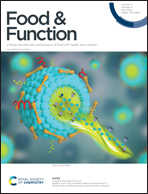Chemical stability of fructans in apple beverages and their influence on chronic constipation
Abstract
The aim of this study was to analyse the concentration of reducing sugars in beverages based on apple juice with the addition of 2 and 4% of native and high polymerized inulin as well as oligofructose. Moreover, the effect of the consumption of this potentially prebiotic beverage containing highly polymerized inulin (12 g per 300 mL) on constipation was analysed. Pasteurization of the studied beverages followed by 120-day storage at ambient temperature, carried out in three independent trials, did not cause the hydrolysis of fructans into reducing sugars. Sensory analysis showed that the presence of fructans in beverages based on apple juice did not change the colour, clarity, odour, flavour, sweetness and acidity in comparison to apple juice. A placebo-controlled, randomized study involving 20 volunteers of age 20–29 with symptoms related to chronic constipation showed that the consumption of juice enriched with highly polymerized inulin significantly (p ≤ 0.05) increased the frequency of bowel movements and facilitated defecation. The final conclusion is that fructans in beverages based on apple juice are chemically stable, do not affect sensory sensation and can help those with chronic constipation.



 Please wait while we load your content...
Please wait while we load your content...